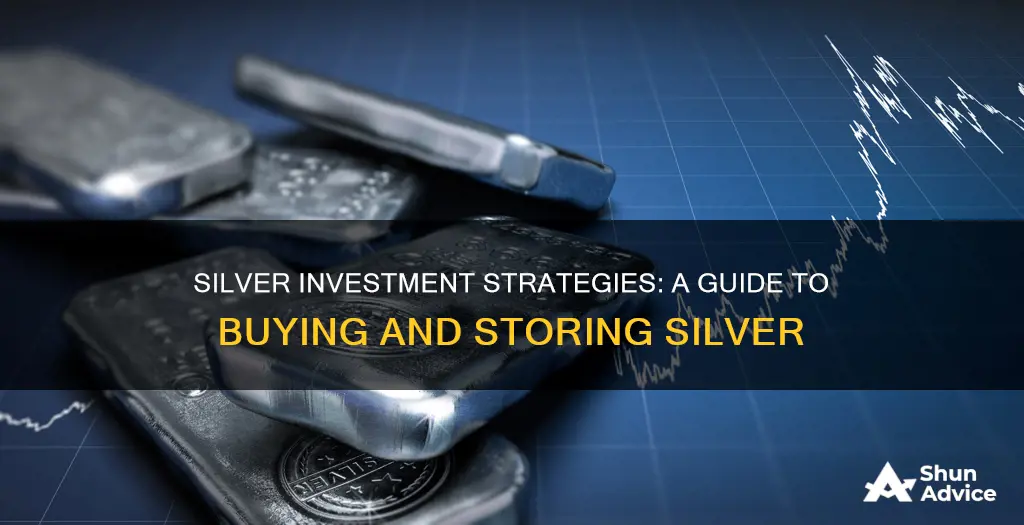
Silver is a popular investment option for those looking to diversify their portfolios. It's one of the most popular precious metals to invest in, alongside gold. Silver is often used as a hedge against inflation and rising interest rates, and its price tends to move inversely with the stock market.
There are several ways to invest in silver, each with its own pros and cons. You can buy physical silver, such as bullion bars or coins, through online dealers, pawn shops, or specialty retailers. You can also invest in silver indirectly by buying stocks in silver mining companies or exchange-traded funds (ETFs) that hold silver-backed assets. Another option is silver futures, which are contracts to buy or sell silver at a predetermined price on a future date.
Before investing in silver, it's important to consider your financial goals, risk tolerance, and timeline. It's also crucial to do your research and seek advice from unbiased sources or financial advisors.
What You'll Learn

Buying physical silver
Before buying physical silver, it's important to be aware of the spot price, which is the current trading value of silver. While coins are marked-up to reflect their rarity and condition, the price of pure silver bullion is based on the value of the metal itself.
When buying physical silver, you can expect to pay a premium to the spot price. Silver dealers will mark up their prices to make a profit. Broker premiums, especially for limited-edition collectible coins, can be steep, and you have no guarantee of making your money back.
You can also buy physical silver from specialised dealers if you want to purchase whole bars or larger quantities of silver.
If you're buying physical silver, you'll need to consider the costs of storing and insuring it. You may choose to store it at home or in a bank safe deposit box.
- Find a dealer you trust. Buying precious metals carries the risk of scams, so it's important to do your research. Some brokerage services sell precious metals, or your financial advisor may be able to direct you to a reputable dealer.
- Watch out for fees. In addition to the premium on the spot price, there may be other fees such as sales tax and dealer markups.
- Store your silver securely. Consider buying a safe or using a bank's safe deposit box to protect your investment from loss or theft.
- Consider buying insurance. This will help ensure your investment is protected in the event of theft or damage.
Overall, buying physical silver can be a satisfying way to invest, as it allows you to physically hold and possess the metal. However, it's important to be aware of the associated costs and risks, such as storage, insurance, and the potential for theft.
Unlocking Tax-Free Retirement: The Power of Roth Accounts
You may want to see also

Silver futures
A futures contract is an agreement to buy or sell a specific amount of silver at a certain price at a defined time. Silver futures are traded nearly 24 hours a day, five days a week, and they offer high leverage, meaning you need to put up relatively little capital to own a large position in the metal.
The CME Group has introduced the mini silver futures contract and the micro silver futures contract, the latter being one-fifth the size of the standard contract.
Trading silver futures can be risky due to the high leverage involved. Small movements in the market can translate into large price swings, and losses can exceed the value of your initial investment. Therefore, trading silver futures is often best left to sophisticated investors.
To trade silver futures, you will likely need special permission from your broker, and you will need to understand how to roll over contracts when they expire if you don't want to be responsible for taking delivery of the physical silver.
Angel Investing: Understanding the Failure Rate
You may want to see also

Silver mining stocks
Some of the top silver mining stocks include:
- First Majestic Silver (NYSE:AG)
- Pan American Silver (NASDAQ:PAAS)
- Wheaton Precious Metals (NYSE:WPM)
- Hecla Mining Company (NYSE:HL)
- Endeavour Silver (NYSE: EXK)
- MAG Silver Corp. (NYSE:MAG)
- Coeur Mining, Inc. (NYSE:CDE)
- Fortuna Silver Mines Inc. (NYSE:FSM)
It is important to note that silver mining stocks can be volatile, and it is crucial to conduct extensive analysis before investing.
Successful People Invest in Themselves
You may want to see also

Silver exchange-traded funds (ETFs)
The iShares Silver Trust (SLV) and Aberdeen Standard Physical Silver Shares ETF (SIVR) are the two main ETFs that own physical silver. The Global X Silver Miners ETF (SIL) is the largest ETF that owns stocks of silver mining companies.
ETFs are a low-cost and popular way to hold positions in multiple companies across an index or within an industry sector. However, silver ETFs are narrowly focused investments. While they can be part of a well-diversified portfolio, financial advisors recommend keeping precious metals investments, including silver ETFs, to between 5% and 10% of your total nest egg to avoid over-concentration, which can heighten your risk.
Silver ETFs have higher expense ratios than the average broad-based equity ETF. The average silver ETF expense ratio is 0.73%, compared to 0.16% for broad-based equity ETFs. Silver ETFs backed with physical silver can also be subject to less favourable tax treatment because they are classified as commodities rather than paper assets.
Investment Calls: Why You?
You may want to see also

Silver IRAs
A silver IRA is a type of individual retirement account that allows investors to include physical silver bullion and other precious metals in their retirement portfolio. Silver IRAs are a great way to diversify your retirement savings and protect your savings against market volatility and inflation.
There are three types of silver and precious metals IRAs: traditional, Roth, and Simplified Employee Pension (SEP) IRAs. Traditional IRAs allow investors to make tax-deductible contributions, but they pay taxes upon withdrawal in retirement. Roth IRAs allow investors to contribute after-tax dollars, but withdrawals in retirement are tax-free. SEP IRAs are for self-employed individuals, allowing them to save for retirement while taking advantage of tax-deductible contributions.
It's important to note that silver IRAs don't make sense for every investor. Silver doesn't generate income in the form of dividends or interest, and silver IRAs can be one of the more expensive options due to their fees. Additionally, if you want to liquidate your silver in the future, you may have to sell it for less than it's worth.
When considering a silver IRA, it's crucial to research the various companies available and evaluate their setup fees, annual fees, and minimum investment requirements. It's also essential to ensure the company you choose is reliable and has a good reputation.
To open a silver IRA, you must have earned taxable income or be the spouse of someone who has. You will need to choose a custodian, provide personal information, and fund the account through contributions or IRA rollovers from existing retirement accounts. The company will then purchase physical silver bullion on your behalf and store it in a secure facility.
Oil Investment: Where to Put Your Money Now
You may want to see also
Frequently asked questions
Silver is a good investment option if you're looking to diversify your portfolio. It's also a hedge against inflation and a safe haven during times of stock market turmoil. Silver is also more affordable than gold.
Silver doesn't generate income in the form of interest or dividends. It can also be quite bulky and may be at risk of theft. You'll need to factor in storage and insurance costs, which can be quite high.
You can buy physical silver, such as bullion bars or coins, or invest in silver stocks, ETFs, or futures.
You can buy physical silver from online precious metals brokers, storefront dealers, pawn shops, some jewellery stores, and specialty retailers.
Silver futures are financial instruments or contracts that give the buyer the right to purchase silver at a predetermined price on a specific future date.







